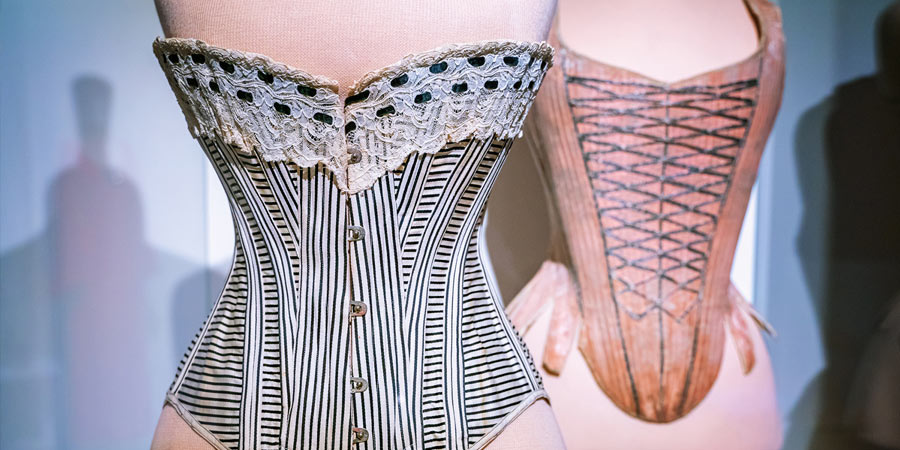Everything you need to know about Corsets

If you have binge watched Bridgerton and marvelled at the costumes, it’s the corsetry in the opening scene which set the tone and has apparently created a “corset shortage” because of an unprecedented rise in popularity. Of course in Bridgerton corsets are used as a parable to highlight restrictions the ladies endure in their everyday lives (more on that later) but damn those costumes are incredible. Our very own MisKnickers has delved into the history of corsetry for us revealing how the corset became fashionable again and explaining everything you need to know about corsets.
A (very) brief history of Corsets
Originally worn by both men and women, corsets seem to have evolved from Hellenistic Greece, where ‘girdles’ - long lengths of cord - were used to both hold the tunic together and create folds and pockets in which one could carry their stuff (‘stuff’ is a proper history word). Over hundreds of years, the corset evolved from simple cords into stiffly starched and glued layers of fabric, laced tightly at the back to exaggerate the breasts and hips while minimizing the waist, and flattening the stomach. In the mid-1500’s corsetry was introduced to the French court by Italian-born Catherine de Medici, and as France set its sights on colonisation, these fashions travelled through The Americas, Africa, Asia, and much of Europe, and solidified as ‘the norm’ when French influence became more entrenched. Corsetry for men began to wane as commonplace in the 19th Century, and by the mid 1800’s men were wearing corsets with discretion, for medical reasons, rather than fashion.
It was also around this time that tightlacing made a short fashion statement that would have a long-lived influence on how people would see corsetry. As the name suggests, tightlacing is the practice of lacing a corset as tightly as possible in order to get the smallest waist. Many adherents also wore a corset to bed in order to train their waists into even smaller proportions. Dress reform was one of the earliest demands made by women involved in what came to be known as First Wave Feminism. Without reform to the restrictive clothing in which they were forced exist, they argued women could not function in an able and constructive way. The restrictive corset was condemned to be an object of disempowerment; further, those that might choose to wear them were shamed for being vain, self-indulgent, and improper.
The Fashionable Corset
That idea of corsetry being somewhat improper has made its way into both popular culture and society at large. Ever noticed how corsets are always worn by the ‘bad girls’ and/or ‘weirdos’ - Betty Page, Madonna, Freddie Mercury, P!nk, and Dita Von Teese. But make something a little bit taboo, and for some of us, it just adds to the appeal. The shape of corsets has always been in flux, changing to suit both the fashion demands, and body shape preferences of the particular time, but these days we are not restrained by either, plus advances in textile technology and production means a whole range of corsets are available; corsets that also consider the comfort of the wearer.
Overbust: covering from the under arms to around mid-hip, this is the most common corset used to give the wearer an hourglass shape and breast support.
Underbust: as the name suggests an underbust corset cover the area from under the breast (bust) to the top of the hips. Mostly worn over clothes, the underbust provides waist reduction without breast support.
Bustier: a flexible boned corset without a cinched waist, starting under the arms, and often ending at the top of the thighs with garters.
Waist Cincher: similar to the underbust, the cincher includes reinforcement over the stomach, and is designed to both slim the waist, and flatten the mid-section.
Not only do corsets look great on everyone, but they are an extremely functional piece of fashion, able to be utilised in a variety of ways. And it’s almost impossible to have an interest in kink, and not appreciate corsetry.
Corsets for Kinksters
Corsets are one of the most fetishised items of clothing - right up there with shoes, stockings, and lingerie. And even if you don’t fetishise the corset as an object, you might have a fetish for a particular fabric (think latex or leather). For some people it’s the feeling of restriction which makes corsets appealing, for others it’s simply part of a sexy outfit. If something has even a touch of the taboo, kinksters will embrace it. But there are some kink practices in which the corset holds a central place.
Tightlacing, as mentioned earlier, is when the corset is worn as tight as possible to achieve a dramatic reduction in waist circumference while the corset is being worn. When the reduction is greater than 10 cm (4 inches) or 20% of waist circumference, a corset is considered tight laced. This practice is only used in short-term wear; for example, a night out, a BDSM event or a photoshoot.
Waist training is the long-term wear of tight laced corsets, the aim of which is to give the wearer a long-term reduction in waist size, and train the body into compressing so that lacing can become even tighter, and smaller corsets can be worn. Waist training is a long-term commitment, that gives a semi-permanent reduction to the waist; months of 23/7 corset wearing can result in a reduction that may last hours; years of wear may give you days, maybe a couple of weeks.
Cathie Jung holds the Guinness World Record for the smallest waist on a living person with a corseted waist measurement of 38.1cm which was achieved by waist training 23 hours a day over many years.
Feminisation and dollification play will often incorporate the use of corsets. Not only are they undergarments more associated with women, but they also help define a shape into a hyperfeminised form. For cross-dressing men, corsets help create more rounded hips, and push the chest up to provide cleavage.
Restraint corsets range in levels of subtlety. At the most basic, is a simple, but sturdy corset with a couple of metal rings onto which leashes, ropes, G-clamps and caribiners can be attached - these are fine for play involving light restraint and/or resistance. As the bondage play increases, so does the durability of the corset, and the versatility of restraint options, resulting in heavy leather corsets, adorned with an array of shiny fastenings. At their most hectic, restraint corsets often resemble a straight-jacket. If you do want to wear a corset just for restraint, be sure it’s made for the occasion, and is built for the planned activity.
How to lace your corset
Generally corsets will be tied together with either ribbons or a lace (like a shoelace, not like the web-like fabric!) Depending on what you want out of your corset, there are pros and cons for both. Ribbon lacing allows for a much better selection of colours and textures, and are often used on corsets designed for fashion purposes. But ribbons don’t do well with tight lacing, and generally lack durability. So if you’re into waist training or corsetry for bondage or tight lacing, you’re going to require a sturdier tie, and this is where laces are best. Sure, the colour selection isn’t as great, and if you’re lacing tight there can be a lot of cord left over, but laces are less likely to slip and loosen while being worn, and rarely require replacement.
Be it for fashion or fetish, or even medical reasons (which is a whole other story) the corset has a long history that shows no sign of ending any time soon. In fact, if anything the corset is on the rise as its controversial past has been somewhat addressed, by both the feminist movement and advances in technology. Today we’re offered us a choice in corsetry that our ancestors never had, and thankfully there’s no shame in wearing them as undergarments or proudly displayed as part of a very sexy outfit.
Here's a quick tutorial on how a partner can help you lace up your corset.



Likes & Comments
No comments yet